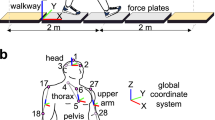Abstract
In this paper, a method of determining the optimal rotation of the humanoid’s waist for momentum compensation around the perpendicular axis of the stance foot during dynamic walk is proposed. In order to perform a task using the arms during a walk, it is desirable that the upper body part, i.e., the arms and the trunk, should not be used for the momentum compensation and should be dedicated to achieving a task. The proposed walk achieves a whole walking motion including momentum compensation only by the lower body. The characteristics of the trunk-twistless walk are analyzed by using the mathematical model. The optimal relative phase of the swing leg and the pelvic rotation appears to be in an angle around. And we also confirm that the torque around the perpendicular axis is reduced in the proposed trunk-twistless walk of humanoid when compared to a standard humanoid walk without the twisting of the trunk or swinging of the arms.
Access this chapter
Tax calculation will be finalised at checkout
Purchases are for personal use only
Preview
Unable to display preview. Download preview PDF.
Similar content being viewed by others
References
A. Takanishi, M. Ishida, Y. Yamazaki, and I. Kato (1985) The realization of dynamic walking by biped walking robot WL-10RD. Proc. Int. Conf. Advanced Robotics, pp. 459–466.
A. Goswami (1999) Postural Stability of Biped Robots and the Foot Rotation Indicator (FRI) Point. Int. J. Robotics Research, vol.18, no.6, pp. 523–533.
S. Kajita, et al. (2002) A Realtime Pattern Generator for Biped Walking. Proc. Int. Conf Robotics and Automation.
K. Harada, S. Kajita, K. Kaneko, and H. Hirukawa (2003) ZMP Analysis for Arm/Leg Coordination. Proc. IEEE/RSJ Int. Conf. Intelligent Robots and Systems.
R._E. A. van Emmerik, and R. C. Wagenaar (1996) Effects of walking velocity on relative phase dynamics in the trunk in human walking. J. Biomech, vol. 29, no. 9, pp. 1175–1184.
C.J.C. Lamoth, P.J. Beek, and O.G. Meijer (2002) Pelvis-thorax coordination in the transverse plane during gait. Gait & Posture, vol. 16, pp. 101–114.
M. LaFiandra, R.C. Wagenaar, K.G. Holt, J.P. Obusek (2003) How do load carriage and walking speed influence trunk coordination and stride parameters? Journal of Biomechanics, vol. 36, no. 1, pp. 87–95.
J. Yamaguchi, A. Takanishi, I. Kato (1993) Development of a biped walking robot compensating for three-axis moment by trunk motion. Proc. Int. Workshop Intelligent Robotics and Systems, pp. 561–566.
S. Kagami, F. Kanehiro, Y. Tamiya, M. Inaba, H. Inoue (2000) AutoBalancer: An Online Dynamic Balance Compensation Scheme for Humanoid Robots. Proc. 4th Int. Workshopon Algorithmic Foundation on Robotics, pp. 329–340.
K. Yamane and Y. Nakamura (2003) Dynamics Filter-Concept and Implementation of online Motion Generator for Human Figures. IEEE Trans. Robotics and Automation, vol.19, no.3, pp.421–432.
S. Kajita, F. Kanehiro, K. Kaneko, K. Fujiwara, K. Harada, K. Yokoi, and H. Hirukawa (2003) Resolved Momentum Control: Humanoid Motion Planning based on the Linear and Angular Momentum. Proc. IEEE/RSJ Int. Conf. Intelli. Robots and Systems pp. 1644–1650.
J. Ueda, K. Shirae, Y. Matsumoto, S. Oda, T. Ogasawara (2004) Momentum Compensation for the Fast Dynamic Walk of Humanoids based on the Pelvic Rotation of Contact Sport Athletes. Proc. of IEEE/RSJ Int. Conf. on Humanoid Robots.
H. Inoue, et al. (2000) HRP, Humanoid Robotics Project of MITI. Proc. IEEE-RAS Int. Conf. Humanoid Robots.
H. Hirukawa, F. Kanehiro and S. Kajita (2001) OpenHRP, Open Architecture Humanoid Robotics Platform. Proc. Int. Symp. Robotics Research.
Author information
Authors and Affiliations
Editor information
Editors and Affiliations
Rights and permissions
Copyright information
© 2006 Springer-Verlag Berlin Heidelberg
About this paper
Cite this paper
Takemura, H., Matsuyama, A., Ueda, J., Matsumoto, Y., Mizoguchi, H., Ogasawarahi, T. (2006). Momentum Compensation for the Dynamic Walk of Humanoids Based on the Optimal Pelvic Rotation. In: Tokhi, M.O., Virk, G.S., Hossain, M.A. (eds) Climbing and Walking Robots. Springer, Berlin, Heidelberg. https://doi.org/10.1007/3-540-26415-9_58
Download citation
DOI: https://doi.org/10.1007/3-540-26415-9_58
Publisher Name: Springer, Berlin, Heidelberg
Print ISBN: 978-3-540-26413-2
Online ISBN: 978-3-540-26415-6
eBook Packages: EngineeringEngineering (R0)




